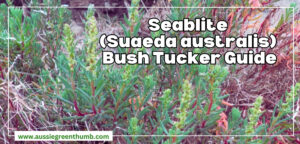Muntries is an interesting plant. It can climb a trellis as easily as it can spread across the ground. Perhaps you’ve got a small garden nook that needs a shrub, or you’re looking to spice up some open ground with a plant that is not just green, but produces some fruit too.
Muntries as it’s known in bush food terms, is ideal for coastal locations because it works a charm on embankments and for sand stabilising. This plant also welcome some lovely guests to your garden in the form of nectar eating birds and insects.
In this guide, we’ll go through an introduction to the muntrie plant, how to grow and care for it, propagation methods, pests and diseases, and muntries as bush tucker.
More...
Genus: | Kunzea |
|---|---|
Species: | K. pomifera |
Family: | Myrtaceae |
Common Names: | Muntries, emu apples, native cranberries |
Plant type: | Perennial ground cover |
Sunlight: | Full sun and part shade |
Height: | 30cm |
Width: | 2m |
Soil: | Well-drained, moderate to strong alkaline |
Fruit: | From year 2 to 3, edible, fragrant green to red berries |
Flowers: | Fluffy, cream/white |
Maintenance level: | Low |
Muntries Plant Details

Kunzea pomifera is commonly known as muntries, emu apples, native cranberries, munthari, muntaberry or monterry. It is a low-growing shrub that has hairy stems, small and egg-shaped leaves, white flowers, and fleshy, edible fruit.
Kunzea pomifera was grown in England in 1889 and was one of the first species of Australian plant to be cultivated in England. Muntrie plant have been incredibly valuable to the Aboriginal population in Victoria and South Australia.
Any leftover fruit collected would be dried or baked into cakes for the winter time. The fruit of the Kunzea pomifera was a vital part of the diet of the Narrindjeri people.
They traded the dried fruit with other tribes in exchange for tools they needed. This plant were also a food source for early settlers – they were used in cakes, jams and chutneys.
History of Kunzea pomifera
Kunzea pomifera was first described in 1855 by Ferdinand von Mueller from specimens he collected on the shores and rocks at St. Vincent's Gulf and Rivoli Bay.
He published the description in a book called Definitions of rare or hitherto undescribed Australian plants. The name pomifera comes from the Latin words pomum meaning "fruit of any kind" or "apple"?and fero means "to cover or bear".
Muntries grow in Victoria and South Australia. In Victoria it grows mainly in sandy soil and in South Australia it grows in sandy soil with limestone.
The berries produced by the Kunzea pomifera have the flavour of a spicy apple and are crunchy in texture. Muntries have many benefits and actually contain up to four times more antioxidants than blueberries. They also provide natural waxes that are good for nourishing the skin.
How to Grow and Care for Muntries
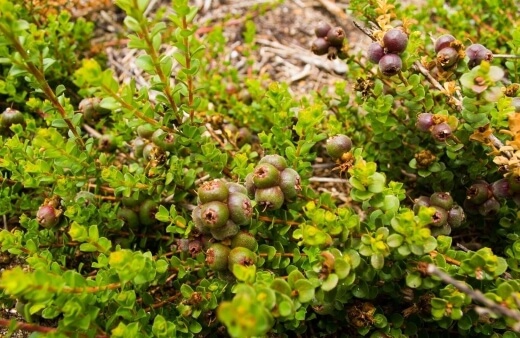
Kunzea pomifera needs to be planted in a place with full sun with well-drained soil. You can improve the soil by adding compost and well-aged manure, then fork it in well. (Learn how to make composting easier here.)
When getting ready to plant your muntrie plant, dig a hole that’s twice as wide and the same depth as the root ball. Remove the plant from its pot, gently loosen the potting mix to free the roots and then place it in the centre of the hole.
Fill the hole with soil, patting it down firmly and water well. Mulch around the base of the plant with an organic mulch like pine bark. This limits weed growth and protects soil moisture.


Get Your Free Guide:
Master Growing Australian Natives eBook
A Must Have Complete Guide for Every Australian Garden
Get Your Free Guide:
Master Growing Australian Natives eBook
A Must Have Complete Guide for Every Australian Garden
Muntrie plants are a groundcover in the wild but commercial growers have managed to trellis the plant, which makes it easier for harvesting and management but also more efficient use of orchard space.
Muntrie plants can be trained easily by weaving the growing plant through and along trellis wires, and then using plant ties to keep them in place.
See our review of the best garden trellis available online as well as some DIY trellis you can make on your own.
Soil
This plant like moderate acidic to strong alkaline soils and they grow best with pH levels of 6.0 to 8.0. The soil needs to be well-draining and if possible sandy in texture. Wild muntrie plants even grow well on broken limestone soils in coastal regions.
Muntries Watering Schedule
You should water your Kunzea pomifera regularly first. Once the plant is established, muntries can handle hot, dry periods but they will always do better if given regular water when flowering and fruiting.
Excessive watering which can lead to extended periods of waterlogging should be avoided but you also want to avoid extremely dry soil conditions. A small water restriction in early spring can actually be beneficial and help in stimulating flowers.
After flowering has happened, muntries need sufficient moisture for fruit growth.
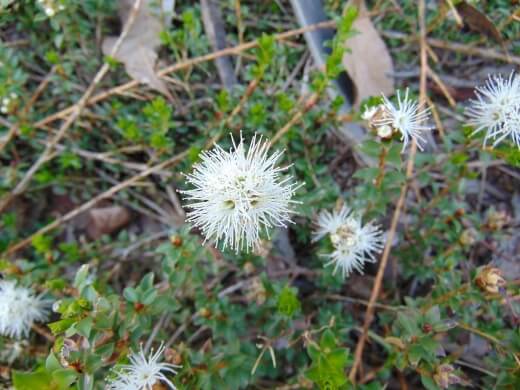
Source: en.wikipedia.org
What Fertiliser to Use
When muntrie plants are young, you can feed them in spring and autumn with a complete fertiliser suitable for native plants. In the first couple of years, it’s important to feed muntries regularly to help boost growth of leaves and stems.
Once the shrubs start to flower and produce fruit, you can then feed your Kunzea pomifera with a native-specific fertiliser after harvesting. Muntries are generally fruit bearing in the third year and you can then reduce the fertiliser frequency to help the shrub focus more on producing fruit.
Many Australian native plants can’t handle high phosphorus levels, so you should use a relatively lowphosphate fertiliser.
In the first season after the muntrie plant has been established, aim to maximise growth so you can develop a good plant structure and produce next season’s fruit. You can do frequent and quite heavy fertiliser applications, particularly of nitrogen.
Getting your fertiliser system right for your garden can be a tricky or daunting process. Fear not! Our complete Australian Garden Fertilisers Users Guide will point you in the right direction, so you use the right type at the right time.
Kunzea pomifera Propagation
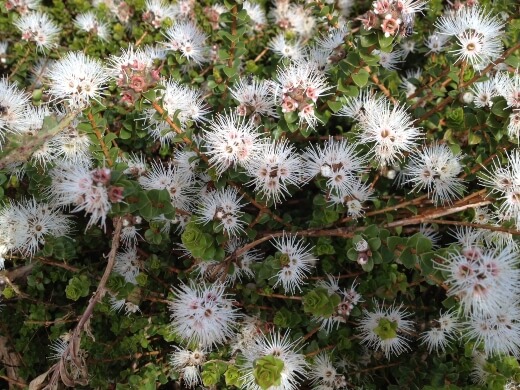
Propagating Muntries from Seed
To grow muntrie from seed, follow these steps:
- Begin by sowing the seeds in a tray filled with seed-raising mix.
- Lightly cover the tray and gently water.
- Position the tray in a warm area and mist it regularly to keep the soil moist.
- Germination can take several weeks.
How to Propagate Muntries from Cuttings
To grow muntries from cuttings, follow these steps:
- Use a semi-hardwood cutting approximately 10cm long.
- Remove the lower leaves from the cutting.
- Dip the base of the cutting into a rooting hormone and insert the cutting into a propagating mix.
- Keep the cutting in a warm area and mist it regularly to keep the soil moist.
- Cuttings can take 6–12 weeks to root.
Muntries Bush Tucker Guide
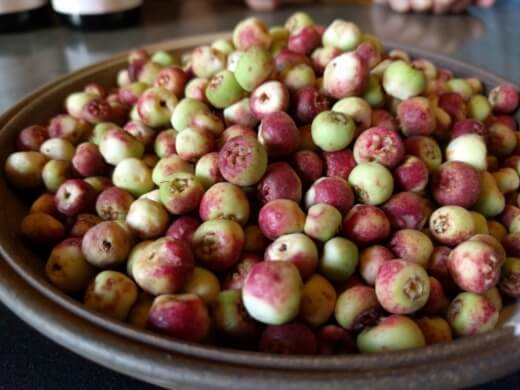
The fruit of the muntrie can be harvested from February. The fruit can stay on the shrub for 2–3 months but rather pick it early since older fruit ends up with a floury taste and lacks flavour.
If you’re applying fertiliser, make sure you delay harvesting for a few days and rinse the fruit well before cooking and eating.
The muntrie berry is one of Australia’s oldest bush foods and is going through a bit of a revival. Muntrie berries have up to 4 times the antioxidants of blueberries so it’s nutritious and delicious.
Kunzea pomifera has been a long time favourite of our traditional people, specifically the diet of the Narrindjeri people of the Coorong in the south-east of South Australia. They were often traded with other tribes, usually after being pounded into a paste which was then dried.
The fruit is a green to red berry with a hint of purple, and has a sweet spicy apple flavour (a bit like cinnamon) and could also be described as a granny smith apple flavour with a sultana finish and dash of spice.
Muntries' Versatility
This plant are incredibly versatile – you can use them in the making of jam, chutney, pies, wine, desserts, sweet and savoury sauces, fruit salad, platters, salads and chocolates. It can also be used instead of apples or sultanas in a recipe, and its spicy, fruity flavour makes a great fruit paste that pairs well with cheese.
Kunzea pomifera pairs well with many dairy products, oil and vinegar-based meat marinades and salad dressings, and egg-based condiments. They are also delicious with white fish, chicken, pork and lamb, and are ideal for game meat such as emu, crocodile, kangaroo and venison.
Muntries Cocktail
Fancy a cocktail? Muntrie berries actually elevate the taste of alcoholic beverages like gin, vodka and white rum. They add a sweet and refreshing note to soda, tonic, mineral waters and lemonade and muntrie berry wine is currently being tested and developed.
Muntrie fruit can be stored at low temperature (freezer < -18°C) for up to 24 months and fruit that has been frozen should be washed prior to use. Fresh fruit can be stored for up to two weeks in the refrigerator at 5°C.
Australia is spoilt for choice when it comes to native bush tucker. If you’re looking for some foodie inspiration (that also grows in the garden), browse through our Australian bush tucker articles.
We’ve got info about native fruits, greens and vegetables but also native herbs and medicinal bush tucker.
Possible Pests and Diseases of Muntries
This plant sometime struggle with plant dieback, which can be caused by soil fungi like Pythium and Phytophthora which is a pathogen that attacks the root system of plants.
Phytophthora dieback is common in Western Australian home gardens, parks and nurseries and is transported in infected soil which can stick on shoes or car tyres.
There are more than 50 species of Phytophthora and they cause a variety of symptoms. These depend on the species affected and the soil conditions where it grows. Plants infected with the disease can suddenly collapse and die within a few days, even if they seemed perfectly healthy.
Phytophthora is more of a problem in waterlogged soil. In well-drained soils, it may not kill the plant but can cause stunting, slow growth and affect the growing tips. After a warm and wet period of 24 hours or more, the fungus can cause enough damage to the roots of the plant to kill it.
You can treat this disease using phosphorous acid (also known as phosphite) which can be sprayed onto the leaves of your muntrie plant.
Muntries Frequently Asked Questions

Source: shopucscarboretum.com
What are some of the known Aboriginal names for muntries?
Munta, ngerp, nurp, nurt (Boanditj), Mantirri (Kaurna), Manter (Ngaiawang), Mantari (Ramindjeri), Mantar (Jaril)
What happens if muntries get too much water?
In the wild, Kunzea pomifera lives on 500-800mm of water a year, which is about the same as Melbourne’s annual rainfall. That means the plant shouldn’t need too much extra water but will do better if you water it during long dry spells.
There is even some evidence suggesting that too much water reduces the intensity of the berry flavour.
What health benefits do muntries have?
The small berries contain high levels of Vitamin C, calcium, magnesium, iron, potassium, sodium and fibre.
What plant family do muntries belong to?
This plant belong to the Myrtaceae family, which includes plants such as eucalypts, bottle brushes, paperbarks, tea trees and lilly pillies.
What are the benefits of muntries?
This plant are considered valuable for their natural waxes and high level of antioxidants. The anti-oxidants and wax are extracted to make hand cream and other beauty products.
It’s an excellent wound healer and is considered a health promoting fruit. Muntrie berries provide a rich source of minerals and are high in dietary fibre, helping to maintain bowel health.
What medicinal properties do muntries have?
The muntrie berry is thought of as a native superfood. Antioxidants help protect cells against the damaging effects of free radicals and improve immune functions, whilst lowering the risk of infection, heart disease, and cancer.
What do muntries smell like?
Muntries are said to have spiced cinnamon and berry notes, with a lingering fruity, cotton candy aroma.
For more Kunzea species, see our growing guides below:
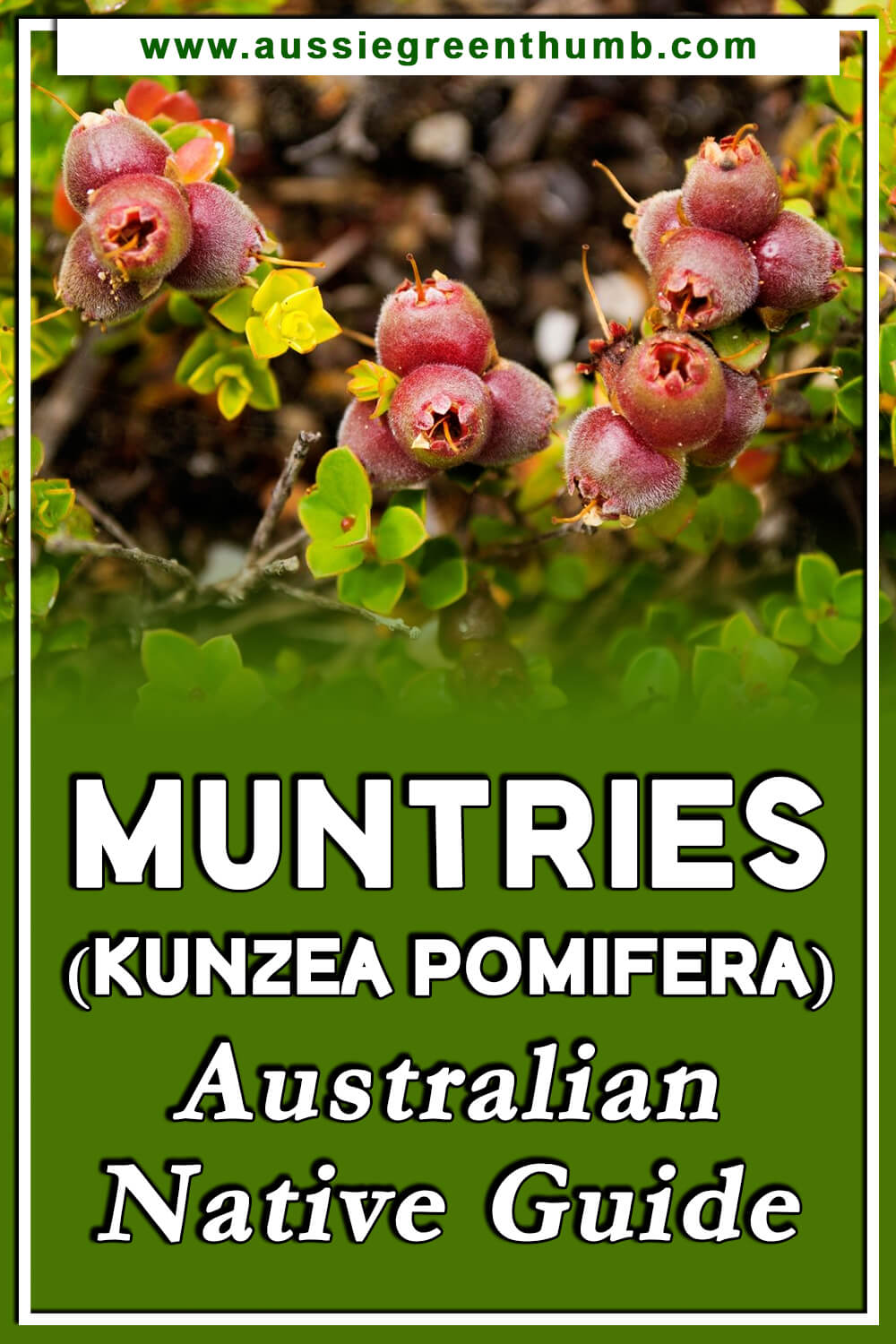
You Will Never Go Wrong with Growing Muntries in Your Garden
In our opinion, a shrub that looks good and produces fruit that tastes good, is a winner. Muntrie plants produce a superfood berry that is a real nutritional boost, and knowing that the fruit is good for you might make you feel less guilty when using the berries to make a delicious dessert.
Whether you choose to wine (and dine) with muntries in a salad, in a cocktail, or as a piece of fruit with cheese, you can go fancy or just enjoy a nibble by yourself.
Kunzea pomifera can adapt to your garden space needs, either by going up a trellis, or spreading out to fill bare ground that needs some greenery. Muntries’ a soil stabiliser for those living in homes at the coast, and attracts more welcome visitors of nature than unwanted ones.
Published on January 3, 2025 by Nathan Schwartz
Last Updated on January 27, 2025




